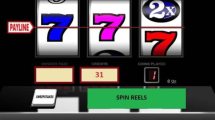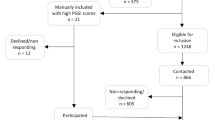Abstract
A theoretical model of persistent gambling is described together with the results of two preliminary investigations focusing on poker machine play under ecologically valid conditions. The subjects (N=80), the majority of whom already had experience of playing, gambled with their own money (either with or without a small “priming” fee), 1) in a laboratory setting on a commercially available machine (Golden Goose) with a genuine opportunity to win and lose (heart rate and subjective measures of arousal were recorded) and 2) in a second study, played under direct observation in a real club setting (subjective arousal, illusion of control and persistence were recorded). The results provided some support for the components of the model, particularly the hypothesized relationship between arousal and persistence.
Similar content being viewed by others
References
Adcock, S.G. (1983). Affect and cognition in persistent gambling. Unpublished master's thesis, Australian National University, Canberra.
Aitken, R. (1969). Measurement of feelings using visual analogue scales.Royal Society of Medicine Proceedings, 62 909–996.
Alloy, L., Abramson, L., & Viscusi, D. (1981). Induced mood and the illusion of control.Journal of Personality and Social Psychology, 41 1129–1140.
American Psychiatric Association (1980).Diagnostic and Statistical Manual of Mental Disorders (3rd ed.. American Psychiatric Association, Washington, DC.
Anderson, G., & Brown, R.I.F. (1984). Real and laboratory gambling, sensation seeking and arousal.British Journal of Psychology, 75 401–410.
Australian Bureau of Statistics (1981). Taxation Revenue Australia, Catalogue 5506.0 Canberra.
Baddeley, A. (1981). The cognitive psychology of everyday life.British Journal of Psychology, 72 257–269.
Barker, J.C., & Miller, M. (1966). Aversion therapy for compulsive gambling.British Medical Journal, 2 115.
Caldwell, G.T. (1972). Leisure cooperatives: the institutionalization of gambling and the growth of large leisure organizations in New South Wales. Unpublished Ph.D. thesis, Australian National University, Canberra.
Chapanis, A. (1976). The relevance of laboratory studies to practical situations.Ergonomics, 10 557–577.
Cornish, D.B. (1978).Gambling: a review of the literature and its implications for policy & research HMSO, London.
Custer, R.L. (1982). Pathological gambling. In Whitfield, A. (ed.),Patients with alcoholism and other drug problems NY Year Book Publishers.
Dickerson, M.G. (1979). FI Schedules and persistence at gambling in the UK Betting Office,Journal of Applied Behavioral Analysis, 12 315–323.
Dickerson, M.G. (1984).Compulsive Gamblers. Longman Applied Psychology, London.
Dickerson, M.G. (1985). The characteristics of the compulsive gambler: a rejection of a typology. In Caldwell, Dickerson, Haig & Sylvan (eds.),Gambling in Australia. Groom Helm, Sydney.
Dickerson, M.G., Fabre, J., & Bayliss, D. (1985). A comparison of TAB customers and poker machine players. InGambling in the 80's,. Griffith University, Brisbane.
Foulds, G.A. (1976).The hierarchical nature of personal illness. Academic Press, London.
Gale, A., & Edwards, J. (1983). Psychophysiology and individual differences: Theory, research procedures and the interpretation of data.Australian Journal of Psychology, 35 361–380.
Goffman, E., (1969).Where the action is. Allen Lane, London.
Golin, S., Terrell, T., Weitz, J., & Drost, P.L. (1979). The illusion of control among depressed patients.Journal of Abnormal Psychology, 9 363–368.
Henshell, R.L. (1980). The purposes of laboratory experimentation and the virtues of deliberate artificiality.Journal of Experimental Social Psychology, 16 466–478.
Koller, K.M. (1972). Treatment of poker machine addicts by aversion therapy.Medical Journal of Australia, 1 742–5.
Lader, M. (1983). Anxiety and depression. In A. Gale & J. Edwards (Eds.),Physiological correlates of human behaviour (Vol. 3: Individual differences and psychopathology). Academic Press, London.
Leary, K., & Dickerson, M.G. (1985). Levels of arousal in high- & low-frequency gamblers.Behavioral Research & Therapy (in press).
Langer, E.J. (1975). The illusion of control.Journal of Personality and Social Psychology, 32(2), 311–28.
Marlett, G.A. (1979). Alcohol use and problem drinking: a cognitive-behavioral analysis. In Kendall, P.C., & Holder, S.D. (eds.),Cognitive behavioral interventions, theory research and procedures. Academic Press, London.
Martens, R. (1977). Sport competition anxiety test.Human Kinetics, Illinois.
Miller, W.R. (ed.) (1980).The Addictive Behaviors. Pergamon, Oxford.
O'Neil, H.F., Spielberger, C.D., & Hansen, D.N. (1969). The effects of state anxiety and task difficulty on computer-assisted learning.Journal of Educational Psychology, 60 343–350.
Rachman, S., & Hodgson, R.J. (1980).Obsessions & Compulsions. Prentice-Hall, Englewood Cliffs, NJ.
Rule, B.G., & Fischer, D.G. (1970). Impulsivity, subjective probability, cardiac response and risk-taking: correlates and factors.Personality, 1(3), 251–60.
Rule, B.G., Nutter, R.W., & Fischer, D.G. (1971). The effect of arousal on risk-taking.Personality, 2(3), 239–47.
Spielberger, C.D., Gorsuch, R.L., & Lushene, R.E. (1970).Manual for the State-Trait Anxiety Inventory (Self-Evaluation Questionnaire). Consulting Psychologist Press, Palo Alto, CA.
Walker, M.B. (1985). Explanations for gambling. In Caldwell, Dickerson, Haig & Sylvan (eds.),Gambling in Australia. Croom Helm, Sydney.
Zuckerman, M. (1979). Sensation seeking and risk-taking. In Izard, C.E. (ed.),Emotions in personality and psychopathology, Plenum, NY.
Author information
Authors and Affiliations
Rights and permissions
About this article
Cite this article
Dickerson, M., Adcock, S. Mood, arousal and cognitions in persistent gambling: Preliminary investigation of a theoretical model. J Gambling Stud 3, 3–15 (1987). https://doi.org/10.1007/BF01087473
Issue Date:
DOI: https://doi.org/10.1007/BF01087473




